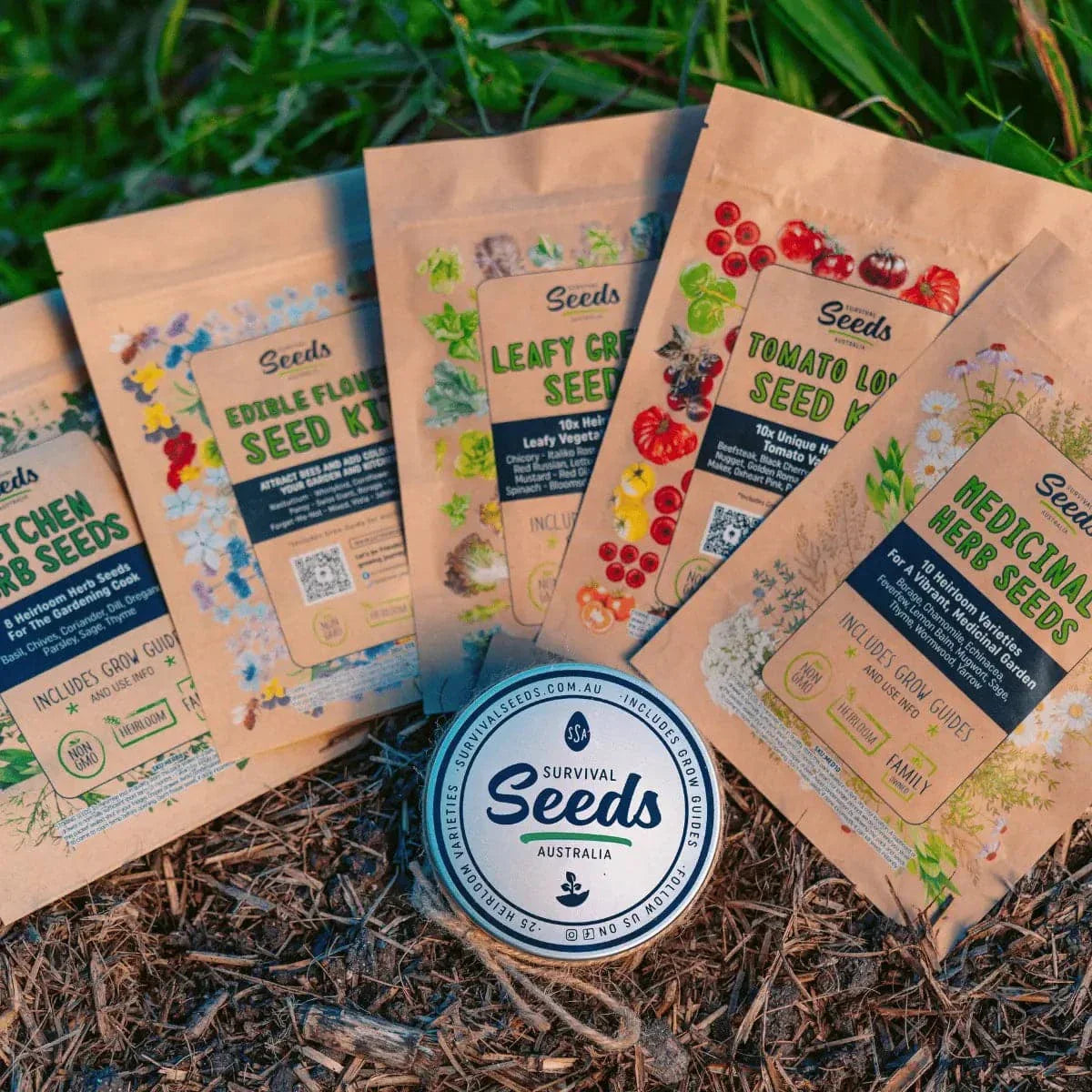Growing Capsicum
Growing capsicums, also known as bell peppers or sweet peppers, is a rewarding endeavour that can yield vibrant and flavorful fruits. Whether you have a spacious garden or limited space on your balcony, this comprehensive guide will walk you through the process of growing capsicums successfully. From choosing the right planting time to nurturing seeds, growing in pots, understanding growth timelines, and using fresh seeds, we’ll cover everything you need to know to cultivate healthy capsicum plants and enjoy a bountiful harvest.
When to Plant Capsicum in Australia
The ideal time to plant capsicum in Australia depends on your specific region and climate. Capsicums thrive in warm weather, so it’s crucial to ensure that the soil has warmed up sufficiently before planting. In most parts of Australia, capsicum seeds or seedlings can be planted outdoors from early spring to early summer. However, in colder regions, it’s best to wait until the risk of frost has passed and the soil temperature has reached around 18°C (64°F) for optimal growth.
To determine the suitable planting time, consider the average last frost date in your area and monitor the soil temperature using a soil thermometer. If you choose to start seeds indoors, begin sowing them 8 to 10 weeks before the anticipated outdoor planting time. This allows the seedlings to establish and grow before being transplanted outdoors.
Remember to adjust the planting time based on your specific location and local climate conditions for the best results. Capsicums require warm temperatures to thrive, so it’s essential to provide them with the ideal conditions during the growing season.
How Long Does Capsicum Take to Grow?
The time it takes for capsicum to grow from seed to harvest can vary depending on the variety, growing conditions, and environmental factors. On average, capsicum plants take around 70 to 85 days from transplanting to produce mature fruits.
From seed germination to transplanting, it generally takes capsicum seeds about 7 to 14 days to sprout, depending on the temperature and conditions. Once transplanted, the plants will begin to grow and develop flowers within a few weeks. After successful pollination, the flowers will develop into small green fruits, which gradually enlarge and change colour as they mature.
It’s important to note that the growing time can be influenced by factors such as temperature, sunlight exposure, soil fertility, and proper care and maintenance. Providing adequate water, sunlight, and nutrients, as well as protecting the plants from pests and diseases, will help ensure healthy growth and faster development of capsicum fruits.
Keep in mind that different capsicum varieties may have different growth rates, so it’s essential to refer to the specific guidelines provided with the seed packet or plant tag. Regularly monitor the plants’ progress, and adjust your expectations accordingly to enjoy a successful harvest of ripe and flavorful capsicums.
Growing Capsicum from Seeds
Growing capsicum from seeds allows you to have control over the entire growth process and access a wide range of unique varieties.
Here’s a step-by-step guide on how to grow capsicum from seeds:
- Seed Selection: Choose high-quality capsicum seeds from reputable suppliers or collect fresh seeds from ripe capsicum fruits. Opt for disease-resistant varieties and consider your preferences for size, colour, and flavour.
2.Starting Seeds Indoors: Start capsicum seeds indoors 8 to 10 weeks before the anticipated outdoor planting time. Fill seed trays or pots with a seed-starting mix, moisten the soil, and sow the seeds at a depth of around 0.5 cm (0.2 inches). Place the trays in a warm location, ideally between 24°C to 29°C (75°F to 85°F), and provide ample light using fluorescent lights or a sunny windowsill.
3.Transplanting Seedlings: When the seedlings have developed their first true leaves and all risk of frost has passed, transplant them into larger pots or into the garden. Harden off the seedlings by gradually exposing them to outdoor conditions over a week before transplanting. Space the seedlings 45 to 60 cm (18 to 24 inches) apart in rows, with rows spaced around 60 to 75 cm (24 to 30 inches) apart.
4.Outdoor Planting: Choose a sunny location with well-drained soil. Prepare the soil by incorporating organic matter such as compost or well-rotted manure. Plant the seedlings at the same depth they were growing indoors, and water thoroughly after transplanting.
5.Care and Maintenance: Provide regular watering, keeping the soil consistently moist but not waterlogged. Apply a balanced organic fertiliser or slow-release granular fertiliser according to package instructions. Mulch around the plants to conserve moisture, suppress weeds, and maintain even soil temperatures. Monitor for pests and diseases, and take appropriate measures to control them.
6.Support and Pruning: As the plants grow, provide support such as stakes or cages to prevent the heavy fruit-laden branches from drooping or breaking. Consider pruning the plants to promote better air circulation and fruit development.
Growing Capsicum In Pots
Growing capsicum in pots is a great option for those with limited space or who want to have a portable garden.
Here’s how to grow capsicum in pots:
- Container Selection: Choose a large container with a diameter of at least 30 cm (12 inches) and a depth of 30 to 45 cm (12 to 18 inches). Ensure that the container has drainage holes to prevent waterlogging.
2.Potting Mix: Fill the container with a well-draining potting mix enriched with organic matter. This ensures adequate moisture retention and nutrient availability.
3.Transplanting Seedlings: Start with healthy capsicum seedlings or transplant them from indoor pots. Place one seedling per pot, ensuring that the root ball is covered with soil and the top of the seedling is at the same level as the soil surface.
4.Sunlight and Watering: Place the pots in a sunny location that receives at least 6 to 8 hours of direct sunlight daily. Water the plants regularly, keeping the soil evenly moist but not soggy.
5.Fertilisation: Feed the plants with a balanced liquid fertiliser every two weeks or follow the package instructions for granular fertilisers. This provides the necessary nutrients for healthy growth and fruit production.
6.Pest and Disease Management: Monitor the plants for common pests such as aphids or whiteflies. Use organic pest control methods like insecticidal soap or neem oil if necessary. Ensure good air circulation and avoid overwatering to prevent fungal diseases.
7.Harvesting: Harvest the capsicums when they have reached the desired size and colour. Cut the fruit from the plant using a sharp knife or scissors, leaving a short stem attached.
By following these steps, you can successfully grow capsicum in pots and enjoy fresh and flavorful peppers right at your doorstep.
How Long Does Capsicum Take To Grow
Capsicums typically take between 70 to 90 days from planting to reach maturity and produce fruit. However, the exact time it takes for capsicums to grow can vary depending on various factors, including the variety of capsicum, growing conditions, and climate.
It’s important to note that capsicum plants require warm weather and ample sunlight to produce fruit, so they tend to grow best in the warmer months of the year.
To ensure that your capsicums reach their full potential, it’s essential to provide them with proper care and maintenance, such as regular watering, fertilisation, and pruning.
How Big Do Capsicum Plants Grow
Capsicum plants, also known as pepper plants, can vary in size depending on the specific variety and growing conditions.
Generally, most capsicum plants grow to be around 30-90 cm (1-3 feet) tall, but some can reach up to 120 cm (4 feet) or more.
Capsicum plants grown in pots tend to be smaller than those grown in the ground, but they can still produce a bountiful crop.
It’s also worth noting that capsicum plants are bushy, and the leaves and stems can spread out widely, so it’s essential to provide adequate space for each plant to grow and support them with stakes or trellises to prevent them from breaking under the weight of the fruit.
How to Grow Capsicum from Fresh Seeds
Growing capsicum from fresh seeds can be an exciting and cost-effective way to propagate new plants.
Here’s a step-by-step guide on how to grow capsicum from fresh seeds:
- Seed Extraction: Collect fresh capsicum seeds from fully ripe fruits. Cut the fruit open and remove the seeds. Rinse them under cool water to remove any pulp or residue.
2.Seed Drying: Spread the seeds in a single layer on a paper towel or a clean, dry plate. Allow them to air dry completely in a cool and well-ventilated area. This usually takes around one to two weeks.
3.Seed Storage: Once the seeds are fully dry, store them in a cool and dark place in a sealed container or an envelope. Label the container with the seed variety and the date of collection to keep track of their viability.
4.Seed Germination: Follow the steps outlined in the “How to Grow Capsicum from Seeds” section above for seed germination and subsequent transplanting.
By following these steps, you can successfully grow capsicum from fresh seeds and enjoy the satisfaction of propagating new plants from your own harvest.
Conclusion
Growing capsicum plants can be a rewarding and enjoyable experience. Whether you choose to grow them from seeds, in pots, or in the garden, providing the right conditions and care will help you achieve a bountiful harvest of vibrant and flavorful capsicums.
From selecting the appropriate planting time to understanding growth stages, potential problems, and the duration of growth, this guide has covered all the essential aspects of cultivating capsicum plants successfully. With patience, attention to detail, and a little green thumb, you’ll be able to savour the delicious and versatile capsicums you’ve grown yourself.










